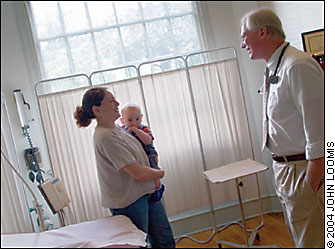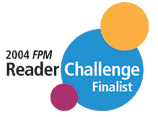
This family physician created a model of practice that allows him to spend quality time with patients.
Fam Pract Manag. 2004;11(8):45-46


“… And they came with their own yearning questions I answer by listening without judgment, the miracle that listening is sometimes enough.”1
When I started my practice in 1987, I was determined to invent a practice style that would allow me enough time to really listen to my patients. I believed that to do my best work as a family physician, I needed time to create meaningful, long-term relationships that were personal and friendly, based on trust and mutual respect. I wanted to practice in a truly patient-centered way, with my patients as equal partners in making decisions about their care. I knew I hadn’t seen a practice model that would allow me to achieve these ideals.
KEY POINTS
The author designed a small, independent practice with low overhead and no insurance contracts so that he could spend more time with patients.
He was able to trim his schedule to 10 patients a day, four days a week and still earn an income above the family-physician average.
Many of the author’s patients have shown their appreciation for his extra attention by remaining loyal to the practice for over a decade.
Starting from scratch
Like most family physicians, I was trained to see four to six patients an hour. After completing my residency, I worked in several family medicine settings, typically seeing 20 to 50 patients in a shift. This usually did not leave me enough time to really feel present with my patients. Visits often ended abruptly, punctuated by a prescription, like a period at the end of a sentence. There was no more time.
To implement the practice style I envisioned, I thought I would need an hour for new-patient visits, physicals and appointments that involved complex health problems or counseling. I would need 15 to 30 minutes for most follow-up visits, depending on the patient and the situation. I could see about 10 to 12 patients a day. How could this work? I wasn’t sure, but I was willing to risk failure to pursue my dreams.
Not long ago, I was talking with a family physician colleague who had started his practice around the same time I did in the mid-1980s. Last year, his practice grossed over $1 million. He was seeing 30 to 40 patients on a typical day and working five days a week with 19 employees, including physicians and physician extenders. At the end of the year, he took nothing home. In fact, he was more than $50,000 in debt. He knew I was successful and happy with my practice and was eager to know the details.
I explained that when I started my practice, I knew I would need to make sacrifices to achieve my goals. I would need to keep debt and monthly overhead to a minimum. I would also have to value my time. I leased an 850-square-foot historic cottage and equipped it with new office furniture, new medical equipment for the exam room and used office equipment. These expenses totaled less than $10,000. I located a lab that would provide equipment and supplies for diagnostic testing, and that would also send a courier daily. For the first nine months I worked alone, enlisting my wife as an assistant on an as-needed basis. I worked one day a week in the health department clinic to meet my pared-down cash-flow needs.
Because I have always believed family physicians provide services equal in value to those of other physicians, I set my fees based on prevailing charges in local urgent care clinics, internists’ offices and other specialists’ offices. I refused to sign any insurance company contracts. I also thought it would be healthiest for me to have a direct financial relationship with my patients. I reasoned that my patients’ insurance is their asset and responsibility. I asked in a friendly way for payment at the time of service, and I generated whatever paperwork they would need to file their own insurance. It was clear in my mind that I was working on behalf of my patients. The thought of playing the role of gatekeeper was abhorrent.
Reaping the benefits
Through my commitments to provide patient-centered care, minimize debt, reduce overhead and value my time, I have succeeded in creating a family practice that lets me devote enough time to listen carefully to my patients. Many of them have now been in my practice for over 15 years. They uniformly appreciate the time we are able to spend together in an unrushed setting. I know when my patients arrive that they have chosen to come because they value the care they receive from me, not because they found my name on a list of “providers.” I feel immense gratitude to each of my patients, which facilitates a therapeutic warmth, a reward in itself. I feel loved by my patients, and I love them. I have repeatedly witnessed “the miracle that listening is sometimes enough.”
My practice is also a remarkable financial success. Within the first 10 months, the practice was self-supporting, which allowed me to quit my part-time work, hire a full-time employee and take one day off each week. On average, I see 10 patients a day, 4 days a week. In the past year, my practice grossed just over $350,000. With my full-time employee and a 95-percent collection rate, I have managed a level of income equal to or greater than that of the average family physician for most of the past five years. I have achieved this without ever signing a managed care or insurance company contract and without compromising my core practice values.
Over the past 16 years of practice, I have been able to purchase and pay off the loan on the small 850-square-foot cottage in which I started, as well as my home in Durham and 100 acres of land. I am also well on the way to paying off a second house that my wife and I built at our farm and the 4,500-square-foot historic home in which I now work. All the income for these purchases has been generated by my little family practice (and from leasing space in the buildings I have acquired through the practice).
What’s the moral?
I write this not to brag but to convince you that a small, independent, patient-centered practice that allows time for developing rewarding doctor-patient relationships can be financially rewarding as well. As family physicians, we must challenge ourselves to create practice models that are in our and our patients’ best interests. Developing meaningful relationships with our patients requires time and an open mind. Those of you willing to take the risks to create such practices may be surprised at the financial success you can achieve. What’s more, professional, emotional and spiritual fulfillment are waiting for you to discover.